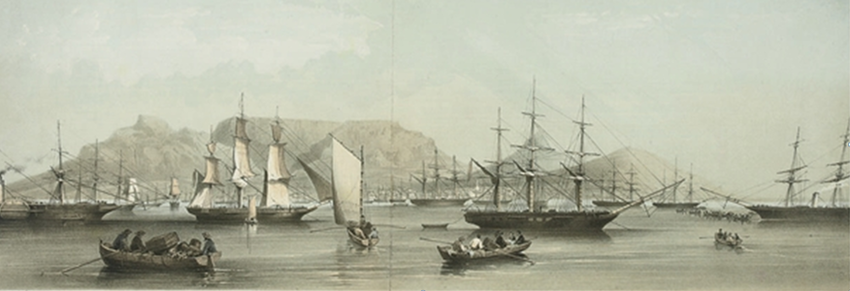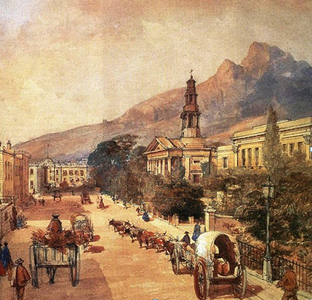Friday December 10th 1852
It is cooler today than it has been for a week, in fact I find it quite pleasant, although the thermometer is still about 80 (26C), - so soon do we become accustomed to changes! Sailors gave us some good songs this evening. Played backgammon after tea with the doctor.
Saturday Dec. 11th. We did not actually cross the line until this evening. We are steering considerably to the east in order to keep as near the coast as possible. Played backgammon with the doctor this evening.
Sunday Dec 12th. A pleasant breeze from the SW which renders it comparatively cool. Captain read Church service on deck today.
Monday Dec 13th. Weather beautifully mild and pleasant. Thermometer averages 79. Backgammon with Dr. this evening.
Tuesday Dec 14th. Noticed this morning that the sea was very much discoloured which is generally a sign of shallow water. Captain stopped engines and sounded, but found no bottom at 80 fathoms (144m/480'). Discovered from books that the River Congo is the cause of the discolouration. We are now just opposite the mouth, though nearly 400 miles distant. It is such an immense river that the effect is observed at a greater distance than this. The Congo has been sounded at its mouth to a depth of 200 fathoms (360m/1,200')), but no bottom found. Sometimes small islands with trees upon them are floated down the river and launched into the ocean! Played whist and backgammon in evening.
Wednesday Dec 15th. Beautiful clear morning and quite cool in the shade. Thermometer rarely above 80 on account of the SW breeze we have had for some days. Played backgammon with Mr Angove this evening.
Thursday Dec 16th. Nothing particular to mention today – weather still fine. Played draughts and backgammon with doctor and Mr Angove.
Friday Dec 17th. Instead of becoming warmer as we get further south, it is decidedly cooler every day. Thermometer is now about 76 (24C). We are much amused every evening after dinner at the games played by the sailors on the forecastle who have an idle hour about that time. Some of the games are rather rough, at least I should not like to join in, but it is rare fun to look on. Played backgammon this evening.
Saturday Dec 18th. Still cooler today. Thermometer about 70 (21C). Cloth clothes are becoming the fashion again. Played whist and backgammon this evening.
Sunday Dec 19th. Church service in the Saloon today. Deck would be rather too cool. Fresh breeze from the SW. Thermometer at 68, rising at noon to 70. Having been accustomed to great heat, we find it now almost cold.
Monday Dec 20th. Still cool weather. The sun at noon is almost vertical, yet the heat is comparatively nothing. Played chess with the Captain this evening.
Tuesday Dec 21st. Cool morning with slight drizzling rain. Cleared up before noon when the thermometer rose to 72 (22C) Saw an Albatross this morning. Played backgammon with doctor this evening.
Wednesday Dec 22nd. Fine morning and warmer than yesterday. At noon today we are between 500 and 600 miles from the Cape. We hope to be there by noon on Friday and are going to steam full power the remaining distance in order to accomplish it by that time. About 4pm one of the floats of the starboard paddle broke. Engines were stopped for repairing the damage, by which we lost 6 or 7 hours as we did not go on until 10.30.
Thursday Dec 23rd. I fear we shall not reach Table Bay until Christmas day, inconsequence of a very heavy sea having set in during the night. This and the time lost yesterday with the float breaking has retarded us considerably. The vessel was pitching during the night almost as badly as she did in the Bay of Biscay. It is rather unfortunate as the Captain much wished to get to the Cape early enough on Friday to clean the ship, and spend Christmas day in comfort. Glass dishes etc. were capsized at dinner today. Having got my sea legs, I walk the deck in safety in spite of the pitching and rolling. I am not at all surprised at the rolling gait which seamen acquire – 3 months of this weather would perfect me in the style.
Friday Dec 24th. Beautiful clear morning – sky quite cloudless. A pleasant temperature not exceeding 71 degrees. Still a heavy swell which occasions much pitching. There is something very delightful in the temperature here - it is like a mild English summer. The days too are now quite long, it is light from about 4am to 8pm. Our shadows at noon fall to the south. At noon today we are about 180 miles from Cape Town. Played backgammon with doctor in evening.
Saturday Dec 25th. We sighted land about 7 o’clock this morning. As we approached Cape Town we could see the Table Mountain (so called from the summit being flat like a table top). A dense cloud concealed the top of it. This cloud is called by seamen the Table Cloth. There are many ships in the Bay – some apparently emigrant vessels – the British war steamer (the “Styx” commanded by Capt. Hall), a large Dutch steamer and sundry merchant vessels of many nations (principally English). Cape Town appears to be a place of considerable size. It forms a very pretty view from the “Bentinck” spread out along the coast and backed by the Table and other mountains.
I can see several large buildings including some churches, which appear to be caricatures of Gothic. We cast anchor at 11 but weighed again to get a better position and finally settled at 12 o’clock. A lieutenant from the war steamer paid us a visit as soon as we arrived. It is a great treat to see some land again – we have lost sight of it for 27 days. A boat came off to us with fresh provisions, but nobody from the ship went ashore today. We had a capital Xmas dinner in spite of the bustle everybody was in during the day – the only orthodox dish wanting was Roast Beef, we had everything else in profusion, and champagne and Madeira in addition to our usual Port and Sherry. We soon got some intelligence of the Caffre war if war it may be called. The seat of the war is about 600 miles from Cape Town, and is now confined to an occasional sally of 40 or 50 Caffres who attack a farmyard and carry off anything they can lay hold of. Our soldiers pursue them and they ******* (#1) are shot – if they escape the farmer loses his sheep or cows and there the matter ends.
Sunday Dec 26th. We went ashore this morning with Captain and Mrs B.W attended service at the Cathedral (St Georges) – which is a plain oblong apartment more like a dissenting Chapel than a Church. It stands at the end of a street, showing what should be its west point, which boasts of an ionic Portico and a tower and bears a distinct resemblance to the Church in London called the “E???????”(#2). There are no aisles or chancel – it is simply a large room – the east end occupied by a gallery, the organ, vestry etc. and the Altar projecting in front of these excrescures (#3) as Pugin (#4) would have called them. The Dean read the prayers and one of the Bishop’s Chaplains preached. The Bishop resided some 10 or 12 miles from Cape Town and the Canons, of whom there are 8 or 10, attend his Church. It was difficult to imagine oneself in Africa! The congregation was thoroughly English, in fact quite a London congregation. I did not see more than half a dozen Hottentots in the Church.
After service we went to procure lodgings for Captain and Mrs Bouchier who will remain ashore during the coaling. The population of Cape Town consists of about 25,000 English, Dutch, Hottentots and mixed races – about one third are English. The newest parts of the Town are beginning to put on a very English appearance – The streets are very wide and some of the best have capital foot pavements. It is much warmer on shore than at sea. We had fortunately taken our umbrellas and were very glad of them to keep off the sun. The ground is everywhere covered with a fine sand yellow and red in colour and the glare of the sun upon it is quite blinding. There is a fine market square and also a large square called the Parade Ground, with a handsome building containing a Corn Exchange and Public Library in the centre of it. The Captain soon obtained lodgings and we left shore at 3 o’clock. About this time a merchant vessel from Calcutta, the “Walmer Castle”, entered the Bay. She cast anchor near us and on signalling each other our chief officer (Mr Munro) found that the Captain is an old friend of his. A party of our officers immediately paid them a visit and exchanged newspapers. They had been some time knocking about and had entered two hurricanes on their way from Calcutta. They had not heard of the Duke of Wellington’s death.
#1 a term not considered polite today
#2 unable to read the original handwriting
#3 unnecessary protuberance
#4 Pugin - architect and designer of Palace of Westminster interior and the tower of Big Ben. He discussed building techniques in the Gothic style with various Cathedrals, as they had experience of working in this style. He wrote to Alfred's stonemason father at Salisbury Cathedral and often visited the family at their workshop and home in Brown Street Salisbury - hence the familiar tone of the reference.
Collated by Rosemary Monk
to be continued






